The Best Corded Oscillating Multitool — Buyers Guide, Review, and Comparison
Electric Oscillating Multi Tool Comparison Table
| IMAGE | PRODUCT | DETAILS | ||
|---|---|---|---|---|
|
Top Pick 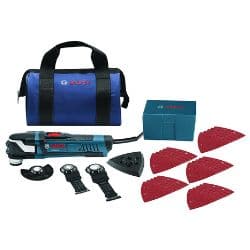
|
Top Pick
|
Bosch GOP40-30B
|
Features
|
Check Price at Amazon Review Bosch GOP40-30B Review Bosch GOP40-30B Review |
|
Best for Professionals 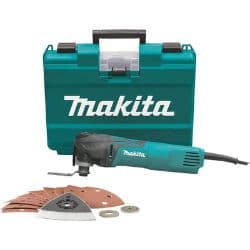
|
Best for Professionals
|
Makita TM3010CX1
|
Features
|
Check Price at Amazon Check Price at Tractor Supply Makita TM3010CX1 Review Makita TM3010CX1 Review |
|
Best for Variable Speed Control 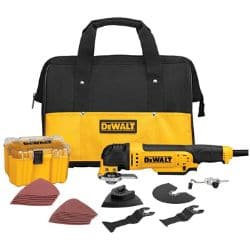
|
Best for Variable Speed Control
|
DeWalt DWE315K
|
Features
|
Check Price at Amazon DeWalt DWE315K Review DeWalt DWE315K Review |
|
Best for Aggressive Angle Cutting 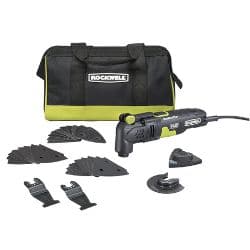
|
Best for Aggressive Angle Cutting
|
Rockwell RK5132K
|
Features
|
Check Price at Amazon Review Rockwell RK5132K Review Rockwell RK5132K Review |
|
Best for Accuracy 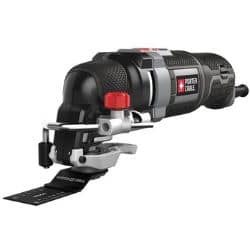
|
Best for Accuracy
|
PORTER-CABLE PCE605K
|
Features
|
Check Price at Amazon PORTER-CABLE PCE605K Review PORTER-CABLE PCE605K Review |
|
Best for DIY 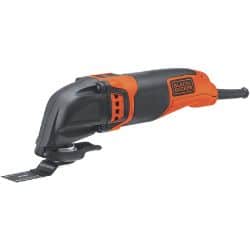
|
Best for DIY
|
Black+Decker BD200MTB
|
Features
|
Check Price at Amazon Black+Decker BD200MTB Review Black+Decker BD200MTB Review |
|
Best for Casual Use 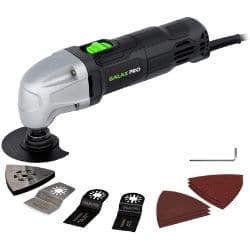
|
Best for Casual Use
|
Galax Pro 22000
|
Features
|
Check Price at Amazon Review Galax Pro 22000 Review Galax Pro 22000 Review |
|
Best Low Power 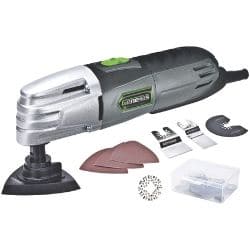
|
Best Low Power
|
Genesis GMT15A
|
Features
|
Check Price at Amazon Genesis GMT15A Review Genesis GMT15A Review |
|
Best for Motor Power 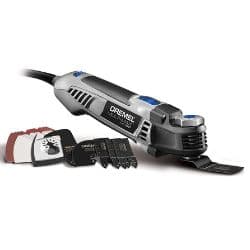
|
Best for Motor Power
|
Dremel MM50-01 Multi-Max
|
Features
|
Check Price at Amazon Review Check Price at Tractor Supply Dremel MM50-01 Multi-Max Review Dremel MM50-01 Multi-Max Review |
Best Corded Oscillating Multitool Buying Guide
Whether you’re a dedicated DIYer, casual home-improver, or trade contractor who demands the ultimate in power consistency — your toolbox isn’t complete without a corded oscillating multitool.
Boasting the flexibility to cut, sand, saw, trim, degrout, and hone when utilized with a cornucopia of attachments — these mains-lead driven units remove the headaches of discharged or draining batteries that can be an issue with cordless models.
Suitable for addressing a massive range of target materials — including timber, acrylic, metal, drywall, and ply — they’re as suited to shaping baseboards and sizing doors as they are slicing old nails and de-grouting tiles. And, with makes and models focusing on both infrequent DIYers through to pro-users, there’s a corded oscillating tool to suit every budget and project demand.
When picking your ultimate corded multi tool, I recommend considering:
- Length of the mains cord.
- Oscillations per minute — OPM
- Variable speed range.
- Speed control dial or throttle.
- Amperage of the electric motor.
- Hex key-free tool attachment exchange.
- Overall weight.
- Number of included accessories.
- In-built LED lamp.
What Is a Corded Electric Oscillating Tool?
To discover the full history, internal mechanics, and uses of all formats of oscillating multitools — check out my complete guide here. But, if you just want to know about corded models, here’s my swift overview.
A corded multitool — sometimes referred to simply as an electric multi tool — is a handheld machine, generally around 12-inches long, that’s powered by a mains cord. However, compared to many electric power tools that use a rotary (spinning) action — such as die-grinders, drills, drivers, and circular saws — multitools utilize an oscillating (back-and-forth) motion.
This movement permits the unit to drive a plethora of easy-switch tool attachments — with the oscillation enabling cutting, shearing, sanding and rasping. Therefore, instead of having a toolbox or workshop filled with infrequently used machines for specific applications — you have a versatile unit that can tackle most around-the-home or trade projects.
As with virtually every handheld power tool, oscillating multi tools are available in both corded and cordless formats. Admittedly, battery-driven machines do have some benefits over their wired siblings — you can operate away from power outlets and you’re not impeded by a snake-like mains lead and extension cable.
However, many DIYers and contractors prefer a corded unit, due to:
- Lighter weight — you’re not wielding both the tool and a hefty lithium cell.
- More budget-friendly — typically mains-driven multitools are at a lower price point than comparable cordless machines.
- Ability to be used immediately — you plug in and go, many battery-powered oscillators require an additional purchase of a cell and charger.
- Greater reliability — power delivery is consistent with electric multitools, cordless machines lose grunt as the battery drains.
- Longer life — with cordless units, the batteries seldom last longer than three years.
Do You Need an Oscillating Wired Multi Tool?
Boasting a whole host of construction, demolition, and honing applications permissible from a single compact unit — the electric oscillating multitool becomes your go-to unit, negating the need for an army of single application machines. With the correct head attachment, you can:
- Slice old nails, screws, and bolts.
- Plunge cut to fit basins and light fittings.
- Shape baseboards.
- Trim doors to fit the jamb.
- Sand down timber.
- Remove rust.
- Eliminate old grout from tiles.
- Fit drywall.
- Remove glue.
- Polish.
- Chip mortar.
- Crafting.
How to Choose the Best Corded Oscillating Tool
Admittedly, wired oscillating tool units share inherent characteristics across the board — mains power, handheld, utilize a back and forth motion, and permit the use of interchangeable attachments. However, individual machines vary in their power output, means of accessory switching, weight, and particular features.
Hence, when choosing your consummate electric multitool, I recommend that you check out the following:
Cord Length
Ok, it’s not a deal-breaker — but the length of the mains lead can impact your user enjoyment and affect the ease of operation.
As these machines aren’t cordless, you’re always going to be tethered — whether directly to a wall socket or an extension cable. The longer the cable, the further away from a power outlet you can operate, and the more freedom you have to address your project.
At the very least, your multitool should have a six-foot cable. Some models, for example, the Galax Pro 22000, have a seriously lengthy cord — others, such as the Bosch GOP40-30B, boast a ball-joint lead connector, permitting impressive maneuverability.
OPM – Oscillations Per Minute
A crucial consideration when exploring corded multitools — the OPM number describes the frequency at which the blade, saw, or sanding attachment vibrates every minute.
Whether you’re looking at a DIY or trade machine, it should at least reach 20000 OPM, with some machines — like the DeWalt DWE315K achieving 22000 OPM.
Variable Speed
For me, variable speed is crucial. Admittedly, some models like the Galax Pro 22000 only offer a single velocity output. Sure, if the machine is only going to be pulled out of your cupboard a couple of times a year — and you’re on a seriously tight budget — this may be sufficient.
However, for the vast majority of DIYers and trade users, adjustable rapidity is the key to work efficiency and impressive results. Being able to alter the intensity allows you to set your sanding or cutting rate to suit the demands of your job — typically, dense materials require a lower speed than soft mediums.
Furthermore, explore how the operational rapidity is selected. Many units, like the pro-grade Makita TM3010CX1, have integrated dials that are preset to five or six-speed outputs. Others, such as the DeWalt DWE315K, have a throttle trigger that permits an infinite choice of velocities.
Motor Amperage
One of the main appeals of wired multitools over their cordless cousins is their typically higher grunt. When selecting your machine, I’d recommend opting for a unit with an amperage of 3.0 amps or higher.
The brawnier the internal powerhouse, the greater the torque — permitting the oscillator to tackle the stubbornest of materials. Furthermore, consider multitools that offer consistent power circuitry, like the Bosch GOP40-30B, that ensures the output speed remains constant — whatever the load or resistance applied.
Tool-Free Accessory Exchange
In the drilling arena — there are proponents of both keyed and keyless chuck systems. Lovers of keyless models appreciate the reduced downtime and the eliminated risk of losing the chuck tightening tool. Keyed addicts consider that manual tensioning offers greater stability and a reduced change of spinning slippage.
But in my opinion, there are no benefits to owning a keyed multitool — unless you’re on an extremely strict budget.
Unlike drills that use a rotary motion, multitools use an oscillating movement. This virtually removes the chance of accessory skidding — making the requirement of intense tightening irrelevant.
Therefore, I recommend going for a machine that has tool-free attachment switching, such as the Rockwell RK5132K. This strips the need for a hex-key, cuts back on replacement time, and saves you valuable time searching for an adjustment tool.
Included Accessories
One serious advantage that corded multitools have over their cordless counterparts is their ability to be put straight to work immediately after unboxing. Many battery-driven models are tool-only — meaning you need to purchase a lithium-cell and charger separately just to switch the darn thing on.
However, different mains-powered oscillating multitools vary in their included accessories. Making the correct choice at the outset can save you time searching online for accessories and prevent additional costs.
It’s rare for a corded model to have no attachments in the box — and at the very least, they usually arrive with one cutting blade and a sander. The volume of extras and their types can be more or less relevant to your projects — and you should consider this factor when selecting your machine.
Furthermore, some models such as the Bosch GOP40-30B and Makita TM3010CX1 include a carry case and tool box for accessories. This offers protective storage, increased portability, and shields against the loss of small attachments.
LED Lamp
If your DIY or trade projects have you working in poorly lit areas such as beneath floorboards, above ceilings, or between drywall slats — you may prefer a multitool that has an in-built LED lamp.
This can provide welcome illumination when your operating space is so restricted that there’s little room to position a secondary work light. Also, check the location of the LED on the multitool itself. It needs to be mounted on the front, not top, of the accessory head — ensuring light floods directly onto your area of address. The DeWalt DWE315K boasts a pleasingly bright lamp that’s positioned perfectly.
Furthermore, a lighter weight tool is crucial for projects that are heavy on time — preventing the onset of fatigue. That said, battery-powered models are usually heftier than their corded counterparts — as you’re wielding a battery as well as the multitool itself.
Weight
The heavier the electric multitool, the more fatigue it will induce on longer projects. Admittedly, the more functions the unit possesses, the more weighty the machine. Hence, while it can be a trade-off, the most sensible approach is to compare weights when looking at machines with similar features.
In most circumstances, corded models are lighter than cordless — as you’re not holding a 20-volt lithium-ion cell. However, be careful if you’re making a heft differentiation between these two formats — as manufacturers are very sneaky.
More often than not, cordless model specifications indicate the weight of the tool only without including the battery. Once the cell is taken into account, this can add another 1.5-2.0 pounds of mass.
Conclusion
With consistent power, no concerns about flat batteries, and with more brawn than their lithium-driven counterparts — corded multitools deliver an abundance of uses from one single machine.
Whether you’re trimming baseboard, cutting drywall, sanding timber, or shearing old protruding nails and screws — these versatile units are the go-to tool for the avid DIYer and trade pro.
When selecting your ideal unit, consider the length of the mains lead, its OPM output, speed range, and the amperage of the motor. Furthermore, check out what accessories arrive with the machine, and the overall heft of the multitool.
Admittedly, they’re not for everyone. Some guys may prefer the operational freedom offered by cordless models — while others may want to stick to a dedicated saw, sander, or die-grinder for individual projects.
But, if you’re seeking a powerful, handheld, single machine that can deliver a wealth of applications — you need a corded oscillating multitool.
Corded Electric Oscillating Multitool FAQs
Q: What Is the Best Corded Electric Multitool?
Boasting a variable speed range of 8000 – 20000 OPM from its 4.0 amp motor, an in-built LED lamp, and promising tool-free accessory exchange — in my opinion, the best multitool corded is the Bosch GOP40-30B.
Q: What Is a Corded Multitool Oscillating Machine?
Power by a mains lead, the corded oscillating electric multitool is a handheld machine that permits you to sand, saw, and cut through a choice of head accessories.
Q: Can You Buy a Multi Tool Saw?
Yes! Most manufacturers retail a plethora of cutting attachments that can transform your corded electric multi-tool into an oscillating saw.
Q: What Is Better a Corded or Cordless Oscillating Multitool?
It depends on your personal preferences and the demands of your projects. Cordless machines offer greater operational freedom away from the constraints of mains tethering. Compared to their battery-driven cousins, corded models are lighter, deliver higher grunt, and promise steadier power output.
Q: Can You Use Screwdriver Attachments With An Electric Oscillating Multitool?
No. Screw and nut driving requires a rotary motion, while multitools utilize an oscillating movement. If you’re looking for a powered screw driving machine — check out my top drill/driver picks.
